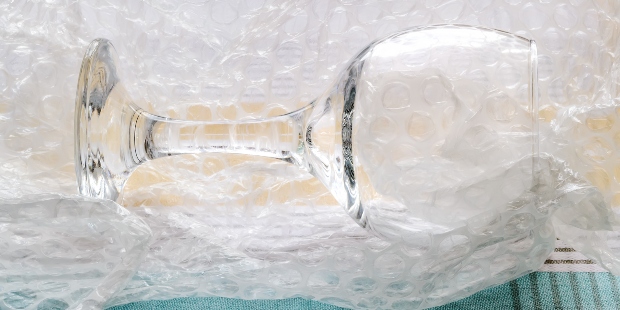Whether it’s a special gift for a loved one or an order from your online store, mailing an item can be stressful—especially if it’s fragile. Packing your item securely is always important for preventing damage during shipping, but fragile items (especially when handmade or vintage) require some extra touches to ensure they’re safe and sound for their travels.
Read on for our packing tips for fragile items to ensure they arrive at their destination in pristine condition.
1. Select the Right Box
The best box will fit snugly around your product without forcing it in and with room for supportive packaging and cushioning materials, AKA void fill. Your box should also be sturdy enough to accommodate the weight of the item being shipped—as well as potentially having other boxes stacked on top of it.
While we’d love for packages to be shipped without getting turned or tossed around—that’s just not the case. The second a box leaves your hands, it enters a massive system where it will constantly come into contact with other packages and people—not all of whom will handle it with the care and attention it requires. In addition to being sturdy enough to contain its own contents, your box should also be strong enough to withstand the rough handling it will invariably encounter during shipping and handling.
A mailer box, also called a roll end front tuck (REFT) box, has multiple sides where the cardboard is folded over itself, which adds stability. The box also has flaps that tuck into itself to help secure it shut (although the flap end should still be taped).
2. Watch Item Placement
Because products shift during shipping, minimizing movement is essential to preventing breakage. If you’re shipping a single item, place it in the middle of the box with adequate cushioning along all sides. Use packing peanuts, crumpled newspaper, or additional filler to further restrict movement.
If you’re shipping more than one item, be sure to pack in order from heaviest to lightest, and follow these additional guidelines.
3. Double-Box for Double the Protection
Both UPS and FedEx recommend double-boxing fragile goods, as well as products with small and spillable parts. To use this method, pack your item in a box as you normally would. Then, pack that box within a larger box, allowing for a few inches of cushioning both inside the interior box and around it.
When double-boxing, a void fill material like packing peanuts, foam, or bubble wrap is recommended. These materials provide a more shock-resistant bumper between your items and the environment around it. Concerned about the environment? Air peanuts, which are made from plant-based starches, are biodegradable and readily available!
4. Acknowledge the Elements
No one wants their packages to get damp or dirty—but it happens. If you’re shipping items that could be affected by dirt or moisture, place them inside a sealable plastic bag before packing to prevent damage from these elements.
5. Different Items Call for Different Approaches
The word “fragile” generally brings up visions of glass, ceramic, or delicate paper items, but it can also be applied to goods like fresh flowers, which run the risk of wilting or getting crushed, or heavy antiques, which are difficult to repair if broken.
For example, fresh flowers should be secured to the box or an additional insert with ties to prevent shifting or bending, and their vase should be packed with bubble wrap or paper for protection. And don’t ship flowers with water—it’s prohibited by some shipping companies because it can leak, which poses risk to your package and others in the vehicle or sorting facility.
On the other hand, cushioning heavy items with packing material can prevent them from puncturing through their box when shifted during shipping, thus exposing them to the elements or potentially harming other packages. Adding bands around the package containing a heavier item also offers protection from bursting.
6. Use the H-Taping Method
A box prone to breaking open during transit is a recipe for disaster. Fortify your box by using the “H-taping” method. First, tape down the middle seam to secure the flaps. Then, tape across each edge on both the top and bottom of the box.
Recommended tape types include pressure-sensitive plastic tape, water-activated reinforced tape, and water-activated paper tape. Avoid sealing packages with cellophane tape, masking tape, duct tape, string, and rope.
7. Add a "Fragile" Label
The reality is that mailer boxes frequently get tossed around during shipping leaving everything from glassware to technology products vulnerable to damage. While there’s no way to prevent all of the handling associated with ecommerce shipping, labeling your box with a “fragile” sticker alerts carriers to the fact that your shipment does require additional care. Feel free to use multiple labels to make your point; just make sure the shipping label remains visible.
8. When in Doubt, Insure the Package
Most major shipping companies as well as the United States Postal Service offer shipping insurance for the value of the goods shipped. If the package is lost or destroyed, you can be refunded for the value of the items you shipped. While this doesn’t replace the item, it does protect you from losing money and would help you refund a customer.
While accidents can and do happen—11% of packages handled in the United States are damaged or misdelivered each year—frequent breakages caused by product packaging inadequacies can result in a loss of inventory, income, and consumer trust. The good news? The majority of shipping damage is avoidable—especially when items are packaged properly using the right techniques and materials.
